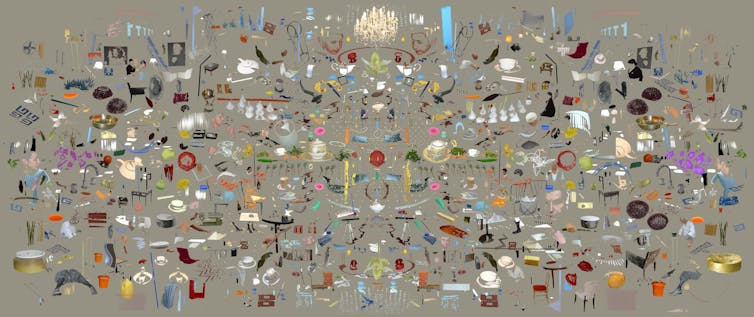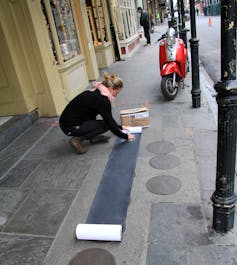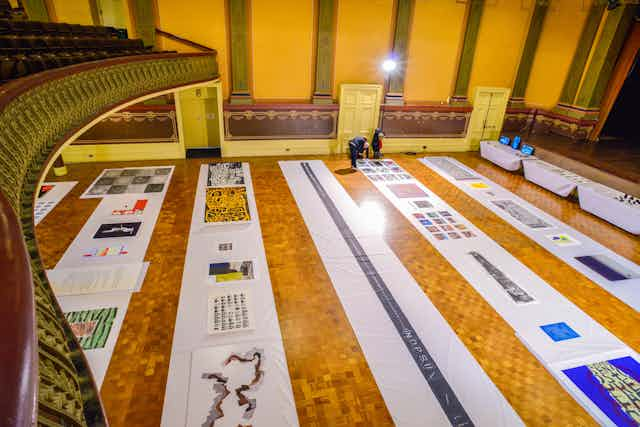Last Thursday, Melbourne artist Gosia Wlodarczak won the 2014 Fremantle Arts Centre Print Award with her work Process Capsule Situations Sofitel (below).
Over the 39 years that the award has been exhibited at the Fremantle Arts Centre, it has played a central role within Australian printmaking – both as a catalyst for innovation and a forum for its dissemination.

Establishing the award
In 1973, the old Fremantle Lunatic Asylum was transformed into a centre for contemporary arts practice.
The time was right. With the State Gallery still housed in the Museum Building in Beaufort Street and showing little interest in local practice, the Fremantle Arts Centre was a major new initiative that both celebrated the preservation of the past (the building itself) and ushered in a new era for the arts in Western Australia.
The early exhibitions were presented with a new kind of energy. The Arts Centre was a place to see new work by younger artists, some for the first time. Most importantly, though, it generated a confidence about being from Western Australia, from Perth and, of course, from Fremantle.

This was the best kind of parochialism that celebrated the local as a place where you could work with assurance and look outside with interest.
That self-confidence convinced the inaugural Director, Ian Templeman, to establish an annual event that would guarantee a national profile. In a relatively well-packed field of prizes and awards finding a theme or topic that would put the Centre on the map wasn’t easy but the decision to choose printmaking has proven to be as canny as it was well-timed.
After a period of expansion during the 60s and 70s, printmaking had established itself as an important creative medium for Australian artists. Printmakers were established in every state and, as a result, the medium had an aura that transcended the Sydney/Melbourne nexus by moving out towards the periphery.
Prints were also produced in multiple copies, so the “original” could travel easily. It was just the kind of national project achievable from a regional base and, with the assistance of Ron Douglas, State Representative for the Shell Company of Australia, the Centre found the funding to host the first event in 1976, with an acquisitive prize of A$500.
Enduring corporate sponsorship
It was also the beginning of one of the most enduring partnerships in Australian art sponsorship. Although not the largest in terms of funding, the consistent support for this project over a 30-year period is a rare example of long-term corporate backing.

In 1996 the company’s ongoing commitment was acknowledged by a change of name to the Shell Fremantle Print Award and the link between the company, the Centre and the medium of printmaking established a nexus recognised nationally.
In 2005 Shell relinquished its sponsorship and in 2007 local brewing company Little Creatures took it up and have been the major sponsor over the past eight years.
The award has attracted extraordinary interest, both from artists and the media outlets across the country and the list of winners now constitutes a certified cohort of leading practitioners.
For the country’s printmakers, it is an opportunity to present their work in a national forum that showcases the best work produced and the innovations and emerging fields of practice within the medium.
This latter role may prove to be the most important and enduring contribution the award has made to Australian visual culture.
The 2014 field
This year 272 submissions guaranteed a tough selection process for the three judges: Peter Burgess, co-head of the Printmaking Department at the National Art School in Sydney; Queensland-based curator and writer Anne Kirker; and Leigh Robb, Curator at the Perth Institute of Contemporary Arts.
Among a field of works they describe WHERE? LINK as “… eclectic, demonstrating both the efficacy of traditional printmaking and the ever changing nature of the print medium”, they identify a number of approaches that show how:
in adapting to change, with the digital so much a part of our lives, printmaking creates an opportunity to critically explore questions such as the role of the handmade, reproducibility, indirect image making, the imprint and the trace

Gosia Wlodarczak’s work was the judges’ unanimous choice for the 2014 Fremantle Arts Centre Print Award because of the artist’s ability to capture “the sights and sensations of the hotel as a personalised space and an elaborate memoir”.
It is a complex work that succeeds in combining a multitude of images — fragments, snippets and traces from photographs — that document an expanding narrative about hotel life.
Their second prize winner was WA artist Susanna Castleden’s Round the World print (Rottnest to Bermuda), an ambitious documentation of a three-week journey inscribed onto a 30-metre roll of paper through tracing, rubbing and mark making.
An additional special commendation was awarded to Torres Strait Islander artist Daniel O’Shane, for his linocut Geb Omai ene Sirr (Coconut Story), and four artists were highly commended: Lesley Duxbury, Rew Hanks, Matthew McVeigh and Kynan Tan.
Some 40 years on the documentation of practice and the research trail it has left in its wake provides a unique record of the evolving nature of the medium during a vibrant period of creative engagement.
The annual Fremantle Arts Centre Print Award runs until Sunday November 16 at the Fremantle Arts Centre.

